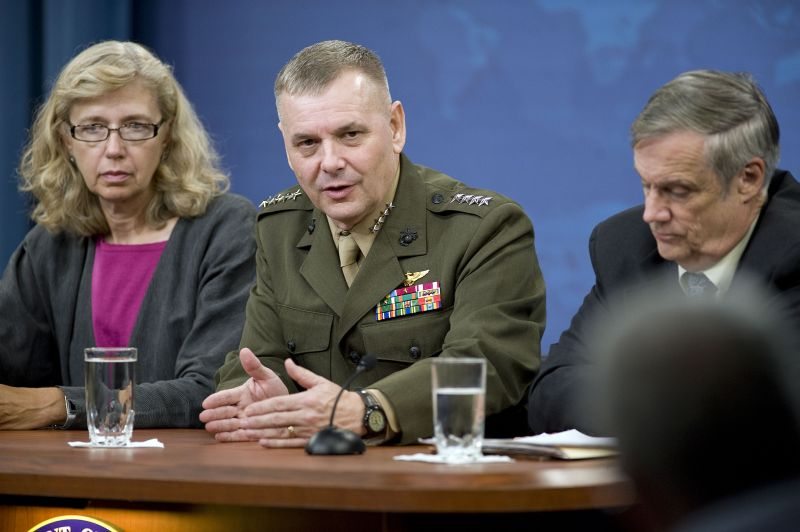Cost savings reflected in the fiscal 2012 Defense Department budget do not represent a cut from current funding levels, but rather a slower rate of growth than has been seen in recent years, the Pentagon’s comptroller and chief financial officer told a Senate committee here March 29.
Defense officials have identified $178 billion in savings for fiscal 2012 through 2016, Robert F. Hale, appearing along with budget representatives from the services, told the Senate Armed Services Committee’s subcommittee on readiness.
With a focus on improving business operations, defense officials identified $100 billion in savings to be reinvested for combat capabilities, and took $78 billion in savings from the department’s top line to help in reducing the federal deficit, Hale said.
“Like Congress, the leadership of the Department of Defense is mindful of the fact that our nation is dealing with significant fiscal and economic pressures,” he said. “Those pressures have a direct impact on the strength of our national defense. We owe it to the taxpayers to make the most of every dollar they entrust to us for the defense of the United States.”
In that spirit, Hale said, the department’s budget requests for fiscal 2010 and 2011 included steps to curtail or eliminate programs “where we had met our procurement needs, or where programs were seriously troubled or provided capabilities that were judged too narrow to justify their expense.”
As part of the past two years’ budget processes, more than 20 programs were restructured or eliminated, including those for the F-22 Raptor and C-17 Globemaster III, the VH-71 Kestrel, the Navy’s DDG-1000 ship program, and the Army’s Future Combat System, Hale said.
The main purpose for that restructuring was to rebalance the military over the long term by reinvesting in combat capabilities and force structure, he said, but it also saved hundreds of billions of taxpayer dollars.
To shed excess overhead costs, the defense budget slows the growth of medical costs, which have skyrocketed from $19 billion in fiscal 2001 to $52 billion anticipated for fiscal 2012, by promoting the use of generic drugs and mail-order pharmacies, and adding increases to TRICARE health plan enrollment fees for working-age military retirees.
The budget also saves $2.5 billion in the next fiscal year by placing a freeze on civilian workforce levels that Hale estimated would save $13 billion over the next four years.
The budget reflects a $2 billion savings from closing U.S. Joint Forces Command and $337 million by closing the Business Transformation Agency.
Hale also noted a projected $4 billion savings by restructuring the joint strike fighter program and $6 billion by reducing the end strength of the Army and Marine Corps. That reduced end strength, he added, is a reduction from a plus-up Defense Secretary Robert M. Gates ordered four years ago when the Army gained 65,000 troops and the Marine Corps gained 27,000 to match demands in Iraq and Afghanistan. The budget calls for reducing the Army by 27,000 and the Marine Corps by 15,000 in fiscal 2015 and 2016.
As part of Gates’ efficiencies initiative, the services have identified $100 billion in savings to be reinvested in higher-priority capabilities, Hale said. Under those savings and reinvestment plans:
- Air Force officials identified $33 billion in savings over four years by making organizational changes in manpower and personnel and consolidating two air operations centers in the United States and two in Europe, as well as consolidating three numbered air force staffs in areas where major commands can assume the workload. The Air Force plans to use the savings to start a new long-range bomber program that can carry nuclear weapons and operate either manned or unmanned. Also, the service plans to invest in more evolved expendable launch vehicles, modern radars for F-15C and F-15E aircraft; and more simulators for F-35 training.
- Army officials identified $29.5 billion in savings over four years by consolidating six Installation Management Command regions into four, closing the Evaluation Task Force at Fort Bliss, Texas, reducing construction projects, and terminating the SLAMRAAM surface-to-air missile program. The Army plans to reinvest the savings by modernizing its fleet of Abrams tanks, Bradley fighting vehicles and Stryker wheeled vehicles; accelerating the fielding of a new tactical communications network; acquiring more unmanned aerial vehicles; and increased funding for suicide prevention and mental health counseling.
- Navy officials identified $35 billion in savings over four years by eliminating selected squadron staffs for submarines, patrol aircraft and destroyer squadrons; disestablishing 2nd Fleet in Norfolk, Va.; and terminating the Marine Corps’ expeditionary fighting vehicle program. The Navy plans to use the savings to acquire six more ships than it had planned; to acquire 41 additional F/A-18 aircraft and add service extensions to 150 more; and to add support to the Marine Corps’ amphibious assault mission.










